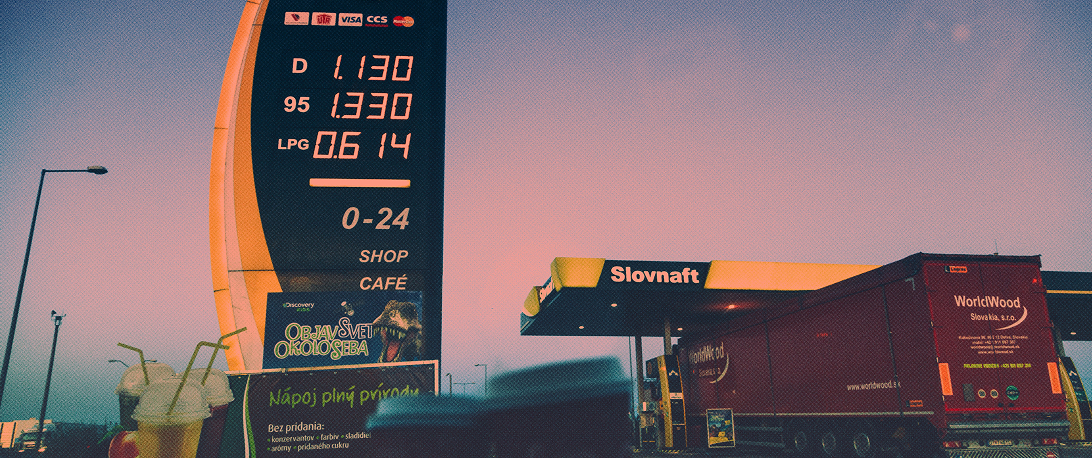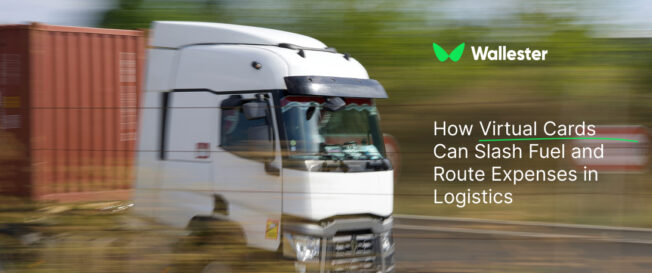Fuel is one of the biggest bills in transport. In 2025, industry data put fuel at around one third of logistics costs, with fuel duty alone contributing over £24 billion to the Exchequer and logistics responsible for a large share of that sum. Prices have stayed lively through 2025. RAC reports show pump costs climbing in July for the second month in a row, with supermarket averages still below the national figure but moving up all the same. These pressures make controlled, data-rich fuel spending a priority rather than a side project.
At the same time, virtual cards continue to scale across business payments. Independent forecasts published in 2025 project virtual card value rising more than twofold by 2029, driven largely by B2B use. That growth reflects how teams prefer controlled cards, clear tagging and fast issue over slow account changes and manual paperwork.
Key takeaways
- Virtual fuel cards help fleets buy petrol or diesel quickly and safely without handling cash or shared plastic.
- Tagging spend by vehicle, route or project gives finance a current view and less retyping.
- Choosing a provider means checking station coverage, fees, pricing rules and useful extras.
- A short rollout plan works best. Start small, add sensible limits, and review weekly.
- Wallester issues cards in minutes, supports phone wallets, and sends clean data into your accounts with controls that fit day-to-day work.
What are fuel cards?
A fuel card is a payment card for buying petrol, diesel and related services at fuel stations. It connects to a business account and can be set up for a company, a depot, a vehicle or a driver. The point is control and clarity. Instead of loose receipts and shared cards, you get a single stream of tagged transactions with clear ownership.
There are three common forms:
- Physical fuel cards. Plastic cards that drivers keep in the cab and present at the pump. Many are linked to branded station networks or multi-brand networks.
- Prepaid cards. Cards that you load with funds first, then use until the balance is gone. These prevent overspend by design and suit teams that want a fixed budget for a route or a week.
- Virtual fuel cards. Digital-only cards you create in a web portal or app. They can be set for a vehicle, route or driver and used through a phone wallet or typed securely when needed. No plastic, fast issue, instant pause.
Compared with cash or generic company credit cards, fuel cards bring better visibility and fewer surprises. They make it easier to see who filled up, where, and for how much, and they help you tidy VAT and other reporting without long chases for paperwork.
How do fuel cards help transportation companies?
Fuel spend touches every part of the operation. That is why better control has a knock-on effect across planning, finance and driver support.
- Visibility that managers can use. Live or daily feeds show spend by vehicle, route and depot, so spikes are spotted while the work is still in motion.
- Sensible limits. Caps per day, per week or per transaction stop runaway spend and keep cards safe if details are compromised.
- Cleaner records. Digital receipts and tags cut retyping and missing paperwork. The same data helps with VAT reclaim and audit trails.
- Safer than cash or shared cards. Named cards with simple rules reduce misuse and make it easy to freeze and replace if something looks off.
- A calmer finance close. Fewer mismatches, fewer manual journals and clearer links between the road and the books.
Further Reading: Enhancing Travel Expense Management with Virtual Cards
Which factors should a transport business consider when choosing a fuel card?
Choosing a card is easier when you check the practical points first. A short checklist keeps you away from fancy features that do not fit the work you actually do.
Network coverage
Start with the routes. List the stations drivers really use on trunk roads, near depots and at regular layovers. Check how your short list of providers covers those points. Some cards focus on a single brand with a tight discount structure. Others cover many brands and independents and trade a wider footprint for simpler pricing. If your routes cross borders, confirm overseas acceptance and any currency fees before you sign.
Bonuses and extra benefits
Extras are nice when they matter to your work. Look for support hours that match your operating day, simple card management for depot leads, and clear ways to handle lost or damaged cards. If loyalty points, car wash discounts or tyre deals are part of the offer, note them, but keep focus on fuel price, availability and data. A perk is only a benefit if someone on your team will actually use it.
Pricing
Read the price list like you would read a route plan. Look for monthly fees, per transaction fees, minimum usage rules and any charges for card issue or replacement. Ask how pricing adapts when volumes change. If the provider offers one consolidated invoice for the whole fleet, check that it includes all the details your accounts team needs, including VAT lines and tags. Keep an eye on foreign currency charges if your routes leave the UK or if your suppliers bill in other currencies.
Quick tip checklist
- Do the stations match our lanes?
- Is the pricing stated openly and simply, without hidden costs?
- Who can we call at 06:00 if a driver is stuck?
- Does the invoice include everything finance needs?
- Can we add or pause cards in minutes?

Why do you need virtual fuel cards?
Virtual cards fit modern operations where teams want control today, not next month. They work well for mixed fleets, regional depots and contractors.
- Instant setup
Create a card for a vehicle, route or driver and use it the same day. Useful when a new contract starts or a replacement is needed.
- Safer by default
There is no plastic to lose. You can freeze or cancel in a few clicks and issue a new card with a fresh number.
- Good for projects
Set a card to end on a date, or after a set amount of spend, so trials and short jobs do not leave loose ends.
- Phone wallet friendly
Add a card to Apple Pay, Google Pay or Samsung Pay and pay at the pump without digging for a physical card.
- Cleaner reporting
Each card carries tags so spend lands in the right place in the ledger. That shortens the time from purchase to posting.
- EV support
Where charging points accept standard card payments, virtual cards can fund both fuel and charging, which helps mixed fleets.
Further Reading: The Complete Guide to Managing Expenses for Transport & Logistics Companies
The best virtual fuel cards for transport and logistics
There is no single winner for every fleet. The right choice depends on where you drive, how you fund spend, and how you want the data to flow. Use this short view to narrow the field, then confirm the details directly with each provider.
- Wallester
Instant virtual Visa cards with per-card limits, alerts and tagging that fit fleet and depot structures. Works with phone wallets where supported. Strong fit if you want fast setup and clean posting to your accounts.
- Allstar Business Solutions
Well known in the UK with wide station access through branded and partner networks. Check current coverage and fee model for your routes.
- WEX Europe Fleet One
Focus on fleet needs with broad acceptance and options across fuel and services. Confirm fees and network for your regions.
- UK Fuels network cards
Multi-brand access across many stations. Useful for mixed routes with varied brands.
- Shell branded cards
Suitable if your routes align with Shell stations and on-site services. Branded programmes often include specific station perks.
Keep the short list to two or three, test them on a single lane, and pick the one your drivers like and your finance team can reconcile with minimal fuss.
Further Reading: Top Ways to Streamline Expense Management Across Transport and Logistics
How virtual cards improve day-to-day fuel management
The practical gains come from small changes that happen thousands of times a year. A driver fills up without calling for approval. A depot lead sees spend rising on a lane and nudges a schedule. Finance imports a clean file and moves on.
- Cards map to the work. Name each card for a vehicle, route or customer. That way, the ledger reflects the plan without extra edits.
- Limits match reality. Set daily or per-transaction caps that mirror the fuel you expect on a run.
- Alerts are useful, not noisy. Choose notifications for large or unusual spends. Leave the rest quiet.
- Receipts do not go missing. Digital records land with the transaction. Drivers do not need to keep paper slips.
- Freezing is quick. If a card looks compromised, pause it and issue a fresh one. The truck still rolls.
A short playbook to roll out virtual fuel cards
You do not need a big project plan. A tidy two-week run is enough to prove value.
Week one
- Map the first lane or depot. Note stations, drivers and typical fills.
- Create cards for three vehicles and one spare for the duty manager.
- Set daily caps and allow fuel station merchants.
- Tag each card to a vehicle and cost centre.
- Ask drivers to add cards to phone wallets where possible.
Week two
- Check the feed into your accounts system. Fix tags or names while the sample is small.
- Review the top-up and spend curve. Adjust limits if drivers are forced to stop twice.
- Freeze and reissue one test card so the team learns the routine.
- Decide on the next lane or depot and repeat.
At the end of two weeks you should know if the approach fits your routes and your books. If it does, add another lane. If it does not, you have learned without a long project.
How Wallester’s virtual fuel cards reduce fuel costs in logistics
Wallester gives transport firms a fast, controlled way to handle fuel and route expenses.
You can issue virtual Visa cards in minutes for vehicles, lanes or drivers. Each card can have a clear limit, a spending window and rules that only allow fuel station merchants. When a card is used, the charge appears straight away in the dashboard with the tags you set, so both depot managers and finance see what has happened without extra calls. If a card is compromised or a driver changes route, you pause the card and issue a replacement in the same session.
For drivers and field teams, cards can be added to Apple Pay, Google Pay or Samsung Pay where supported. That means fewer delays at the pump and no need to carry plastic. For finance, a daily feed and simple exports keep records current and VAT-ready. If you run mixed fleets or cross-border lanes, multicurrency support and per-card settings help you keep budgets separate and predictable.
What teams value in practice
- Instant card creation for new routes and short jobs
- Simple limits that match real fills
- Alerts that help, not distract
- Clean data that posts to the right place
- Quick freeze and reissue when plans change
Try it in one area first
Start with one depot or lane. Issue a handful of cards, set sensible caps and ask drivers to add cards to phone wallets. Review live spend each morning for a week. If you see fewer calls about approvals, fewer missing receipts and cleaner entries in the ledger, expand to the next lane.
Create your Wallester business account, issue your first virtual cards and run a one-week pilot on a single route. If it saves time and tidies the books, scale from there.


